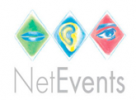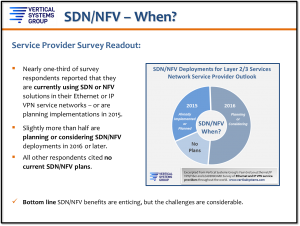06 May One Two Three – That’s How Network’s Meant to Be
 NetEvents 2015 Cloud innovation Summit
NetEvents 2015 Cloud innovation Summit
Tiburon, CA. April 23, 2015
Transcript from Debate Session III –
One Two Three – That’s How Network’s Meant to Be …
 Good morning. I’m Erin Dunne, I direct the research practice for Vertical Systems Group. Welcome. Thanks to NetEvents and I think we just might sit here and stare out at the most beautiful view ever, rather than talking, what do you think? It’s 30 minutes. All right, so we have the next 30 minutes with my distinguished panel here, to talk about a little bit different of an aspect of the cloud services SDN and NFV than you’ve heard before. Which is everything we’ve heard from the previous speakers, the last couple of panels, plus the keynote comes down to one basic thing – none of this happens unless you have a really good network.
Good morning. I’m Erin Dunne, I direct the research practice for Vertical Systems Group. Welcome. Thanks to NetEvents and I think we just might sit here and stare out at the most beautiful view ever, rather than talking, what do you think? It’s 30 minutes. All right, so we have the next 30 minutes with my distinguished panel here, to talk about a little bit different of an aspect of the cloud services SDN and NFV than you’ve heard before. Which is everything we’ve heard from the previous speakers, the last couple of panels, plus the keynote comes down to one basic thing – none of this happens unless you have a really good network.
It is immaterial what that network is — wireless, wireline, layer 1 through doesn’t matter, it better work and it better be available everywhere. The customer needs a reliable access connection to that network. So we’re going to try to stay on that topic here, it’s going to be hard. But we are going to try to stay there because you’ve had so much information about all of the different aspects of cloud. So we’re going to try with the network.
As I said, I direct the research practice for Vertical Systems Group and we have made a business of the past almost 30 years of tracking the enterprise usage of data services, data networking services. Particularly wireline. This becomes all the more important now because you have a huge migration market out there for legacy services. They’re still there. I know you hate hearing about them but it’s not sexy, private lines, there’s ISDN, there’s PRIs we talked about earlier at breakfast. They’re still there. They are declining and they are migrating but you have to take into account the impact of those when we talk about newer networking services and the cloud.
The service providers are tasked now with migrating those customers. You have many large service providers out there that have said, the old stuff is going away and it’s going away by date X. Doesn’t matter what that date is but we’re moving everything to IP. That’s a huge task. So we’re going to talk about how SDN and NFV impacts that. We’re also going to talk a little bit from the enterprise perspective, we’re going to follow the money. The enterprise customer is the start of that money flow which is that they pay a monthly bill to a service provider and they expect something to happen for that monthly bill.
That creates the flow straight down the line whether it’s service providers, equipment vendors, test vendors, software providers, cloud providers. That provides the money flow, and I think that’s a very interesting way to keep remembering to look at that. Because if we don’t keep considering their needs – and that’s going to be one of the first question I ask – what are the customer needs? What are your customer needs from the panel’s perspective? Then we start to lose the vision.
I only have one quick slide, and it’s great because the other two analysts ahead of me did a whole bunch of numbers. As I said right at the beginning, we’re going to focus a little more on the network here. So this is a quick look at a recent survey that Vertical conducted of layer 2 and layer 3 service providers. Again, keeping within that focus area. The question was, what do your deployments look like for SDN and NFV within the layer 2 and layer 3 space?
As you can see here, about a third of the service providers are currently using SDN and NFV or planning it for this year. About half of them are looking farther out, and you get about 15 percent or so that have no plans. Now if we really added up and sliced and diced all the numbers you saw earlier today, these figures line up. But what you don’t see here, which is going to be a nice topic of discussion with our panel, is how are Service Providers using SDV and NFV? Is it from the networking perspective? Is it to enable new services? Or is it on the back end and not available to the enterprise customer? So those are interesting aspects of this whole SDN and NFV rollout. In where it’s being used, how it’s being used, who’s making the decision. Is it the CIO, is it the CTO?
So with that, I am going to introduce our panel. In fact, you know what, I don’t need to introduce the panel. I’m going to let you guys introduce yourself and then we’ll start with a couple of questions. I also just to keep this moving here – because we’re going to be here for exactly 30 minutes because everyone needs their coffee – if anyone has a question, put your hand up here, make some noise, because we’re happy to answer it while we’re going with the flow, so we don’t lose it by the end.
So first of all, so let’s start right here and just to a quick introduction.
 |
 |
 |
| Jeff Baher Sure, thanks Erin. I’m Jeff Baher, I’m the Senior Director of Solutions Marketing at Dell for our NFV and SDN solutions. |
Paul McCluskey Hey, I’m Paul McCluskey, I’m Director of Business Development for CENX. We’re a service orchestration company. I look after our partner ecosystem. |
Kevin Vachon I’m the same person that introduced himself in the first place. I haven’t changed since. |
Erin Dunne
Yeah, Kevin doesn’t need an introduction here and because of that, we’re going to start with him. Because as I said, we’re trying to talk about the network here and the MEF is an integral part of that. So Kevin, what was it a couple of quarters ago, the MEF introduced what they’re calling the third network? Which from our perspective is kind of the amalgamation of a lot of the best of all the networking technology. So do you want to give us just a quick overview of what you guys have done?
 Kevin Vachon
Kevin Vachon
Sure. Yeah, I’ll just give you a little bit of background to this and then I’ll touch on a few, I guess, what we call critical success factors to making this thing a reality. So I think Jeff had a good infonetics slide showing the history of the carrier Ethernet market. So since 2001, MEF has been driving, enabling the growth of this market which is now $80 billion-plus. We have Ethernet replacing TDM as the general purpose transport mechanism for both business services and mobile traffic.
You’ve also had carrier Ethernet becoming much more sophisticated over many, many years with all the industry work that’s gone on, capable of supporting numerous types of applications, vertical markets, a lot of very specialised engineering you can put into the services in terms of how you transport traffic and so on. In terms of trends, you’ve got this – we’ve heard a lot about services, dynamic services, we’ve heard a lot about orchestration today. So you’ve got these trends to more on-demand, dynamic services, automation, using orchestration.
We also have the – these new services will be instantiated or orchestrated by several different means, traditional means; somebody puts an order in, the orchestration BSS systems will turn these services on. It could be through a self-service portal, it could be through – from a cloud application or an upper-orchestration layer. There’s also the dynamic of a – just a general pressing need for automation because of this $80 billion product and service market. There’s just a lot of services being sold, whether they’re dynamic or not. So you have to automate.
Some of that automation is also driven by price pressures in the market. You talk to a lot of service providers, they love Ethernet but they don’t like so much the fact that the price points are being driven down, in particular in some economies. So the third network does three things. One is it’s designed – it’s a concept and it’s designed to bring together the availability, ubiquity of the internet, simplicity with the qualities and the qualifications of carrier Ethernet 2.0, the ability to have predictable performance, end-to-end service assurance, security and so on.
But on top of that, you then build the dynamic capabilities, dynamic service capabilities that we’ve been talking about, and you add an orchestration layer, which we’ve defined as lifecycle services orchestration. Orchestration happens on a layered basis. MEF is all about connectivity services. So accordingly, orchestration that we’re involved in is really about these connectivity services. It’s really about automating the lifecycle of the service from an end-to-end basis. We’re heavily involved with defining those lifecycle elements. So we call it lifecycle services orchestration.
So we think there’s probably four things that are really critical to make the Third Network concept a reality. Number 1 is 2.0 – carrier Ethernet 2.0 becomes a general fabric upon which new innovation can be built. When you’re talking about layer 2 services and not layer 1, accordingly there’s a lot of stuff we’re doing to continue to globalise 2.0, to bring small providers into the standardised environment. We think that SDN and NFV become critical components, obviously, to build out the dynamic services to enable orchestration.
 I should point out that a critical element of MEF’s – or a key component of MEF’s strategy is to enable operators to have a migration path to bring SDN and NFV into their networks. So we need to be able to orchestrate services that are being delivered over traditional and proprietary environments where SDN and NFV are being added over time.
I should point out that a critical element of MEF’s – or a key component of MEF’s strategy is to enable operators to have a migration path to bring SDN and NFV into their networks. So we need to be able to orchestrate services that are being delivered over traditional and proprietary environments where SDN and NFV are being added over time.
Again, I mentioned the – so number 1 is 2.0 is the fabric upon which new functionality will be built, so we have to globalise it. You need to be able to orchestrate services over current technologies. I think that – I guess I can squeeze this into two – well the other – another – a third point would be that services need to be orchestrated across multi-provider networks because in many, many, many cases there are multiple service providers required to deliver a service to a given enterprise customer. So you can orchestrate within your own footprint but if you have these ugly manual processes to turn a service no when you’re involved with wholesale transactions, it all falls down. So of course the APIs have to happen between providers and so on and so forth.
MEF has done – we had a lot of proof of concepts at our GEN14 event last year and quite a few of them were involving automation across multiple-provider networks. Some good stuff happening in the market. There was a discussion in the first panel about the change in the standards landscape. I would say it’s more it’s rapid transformation, it’s almost upheaval which is the good thing. So there’s a huge amount of collaboration now required. Started and still required to make this whole thing work so we’re putting emphasis on collaborating amongst the traditional SDOs, the associations like MEF as well as the open source projects which have changed the game in a very positive way.
So there’s a bit of a mouthful about the third network.
Erin Dunne
That’s a pretty nice overview, right. so I want to make a comment here that someone from the audience or from the first couple of panels might not like… but when you look at virtualising these different areas of our industry, the first – you heard Facebook, you heard AWS, all that. Well you know what, that’s easy as compared to what we’re talking about here. Why? Because it’s newer. It’s a relative greenfield operation, hasn’t been around for 25 years like a lot of these networks out there, maybe even longer. We also heard about some of the datacentres, right? Again, easy. Relatively localised. You can almost – you can touch everything you need to.
So as compared to what we’re talking about here which is hundreds and thousands of endpoints all over the world, and attempting to have them talk to each other using the same language and using the same technologies is a very difficult undertaking. So it’s great to hear what the MEF is dong about that.
I want to throw it over to CENX here who has a lot of goals with the orchestration to help all of these networks, whether it’s cross-domain, whether it’s cross-border, cross-whatever to be able to enable this kind of vision. So I’m going to hand it over to you for just a moment.
 Paul McCluskey
Paul McCluskey
Okay. So I’m an old operations guy, so some of the stuff that I installed is still out there, quite scarily.
But that is part of the problem for the service provider though. If you look at the amount of money they spend on infrastructure every year, especially in the US, look at the wireless carriers, tens of billions of dollars. That stuff’s not going to go away. So we know that NFV is necessary. But that’s not the answer, an overnight. You can’t just switch everything off and replace it. All of that infrastructure’s been paid for, it’s earning money. So there’s a need to not just orchestrate across the new infrastructure but also across the existing infrastructure.
So how do you offer services ubiquitously across your existing and all of the new infrastructure at the same time? So I think that is a big challenge for the service providers as we go through this transition. I don’t think – it’s just not going to happen overnight.
Erin Dunne
No, and it’s not simple. Can we comment on that? How does Dell play here? Because I wanted to make comment that when I started to introduce the focus of our panel, layer 2 and layer 3 networking and you see someone from Dell sitting up here and say, hmm, how does that fit in? Well we want to hear that.
 Jeff Baher
Jeff Baher
Yeah, so first of all we do a fair bit in layer 2 and layer 3 networking.
But what I think is one of the bigger questions around the third network and a lot of the promise of where we’re going is this question of who and who’s really going to be in charge of getting us from where we are today to where we want to go. There’s an IT thought process and experience set, there’s a network and CTO experience set. Maybe it’s an either/or or it’s some combination. But where we want to go to is a combination of experiences that both of these different organisations have and collectively we’ll be building a new foundation on top of that.
So a lot of it in terms of who will be in charge and then that will then drive different ways in which this will take shape. This is probably not going to be a lift and replace what is already currently in the ground or in the infrastructure. So there’s a significant shift in architecture and in the development of NFV and SDN technologies, driven partly by the thinking in the organisations that’ll be behind that.
Dell has been on the IT side obviously for many years, this is bridging and driving a lot of our experiences into the carrier community.
Erin Dunne
How important are standards? We’ve got a standards guy up here. How important is it to make that happen? Do you need the MEF? Do we need all of these other organisations that the MEF is doing a lot with their Unite project to bring together, to make this happen? Do you want to start? Paul, do you want to comment on that?
 Paul McCluskey
Paul McCluskey
Yeah, so I guess the – I mean standards historically, I think it was mentioned earlier about the speed at which standards get defined and then get adopted. It is going to have to move a lot faster than it used to, I think that’s for sure. One thing I have seen though is there appears to be a lot more collaboration between different standards bodies now. I think you made reference to that in your opening section there in terms of the lifecycle orchestration and the fact that you have the ONF, you have ETSI, you have all these different bodies working together.
Even now I think the TMF, if I’m right…
Erin Dunne
Right, they just jumped on into that program, right.
Paul McCluskey
Yeah, that’s right, so I think if that’s helpful then I think that’s a good thing. But it’s going to have to happen quickly. One of the things that’s going to be interesting in terms of how this plays out is how much can you get done with the standards that have been defined already. Then what’s up to the vendor then to differentiate. You can’t differentiate with the box any more because that’s been taken away. So now you’re on a standard compute platform. So the vendors, the traditional equipment vendor now has to differentiate in software. So it’ll be interesting to see how that plays out, whether that creates islands of capability based on that, where service providers are buying based on the additional features that are being delivered outside of the standard, for example.
Erin Dunne
Jeff, how do you differentiate? If you’re utilising the standards, how does it happen?
 Jeff Baher
Jeff Baher
Yeah, so I think it’s a combination of open standards and source. I think from Dell’s perspective, we see NFV and SDN playing out similar ways in the way the laptop in the server industries have. Where there is more of a horizontal orientation towards ecosystems, there is semiconductors, there’s systems, there’s operating systems, tear’s applications. When we think at this third network, this move towards NFV, there’s I think, a healthy debate around the way in which ecosystems get constructed. Whether or not they become more vertical, which is I think the way we are – the generation we just now are trying to exit, versus something that’s more horizontal. I think that changes the rate of innovation, it changes the economics.
Dell did pretty well in the previous generation. Based on that kind of approach and that philosophy, more of a horizontal orientation. We think that’ll play nicely in the way in which NFV is taking shape. It I think then does shine the light on the application development and that rate of change which is so critical.
Erin Dunne
Right, any comments there?
 Kevin Vachon
Kevin Vachon
I’d just make a comment on differentiation. When you look at the old world of connectivity services, they were very, very rigidly standardised. What MEF did was interesting in that the services that MEF has built is more of a framework. There’s a huge amount of opportunity for differentiation within your framework. You can implement the services in different ways, you can differentiate based on SLAs, you can differentiate based on features like on-demand self-service portals, the ability to throttle bandwidth up and down, performance guarantees, how fast you turn the services on, how you bundle the services, services pricing and so on and so forth.
So on one hand, the standards – because of that flexibility, it is a little bit more difficult to enable the interconnection of hundreds of service providers around the world because there’s that latitude. On the other hand, we’re not boxing people into very vanilla commodity offerings.
Erin Dunne
So one question I’d like to throw out to you guys is what are the top things that your customers – and I’m going to keep that deliberately vague because customers come in all shapes and sizes. What do they ask you for? I’m going to take the role here of the enterprise because we don’t really have one, although Kevin probably could roll up some of the info that you get, your feedback from your enterprise participants in the MEF. But when it comes to layer 2 and layer 3 services, all of our research first points to the simple stuff. Which is, from an enterprise perspective, what do they want out of their network? They want to be able to get it wherever they want, they want the speeds and the feeds to meet their needs. They want it to be well priced and they want it to be reliable.
All right, but that’s a given. The market has done a good job over the last many years of meeting those needs. Not that we’ve stabilised on that, we start moving up – I can probably say we’re moving up the stack a little bit. These are the types of things that NFV and SDN are going to be required to enable. Because you just can’t do it the old way. So things are having to change and we’re seeing those changes right now.
The first is, I want a quicker set up. You’ve heard it earlier on some of the panels, right? you’re talking weeks, months, if it’s a global network, if you’re trying to bring fibre, if you’re trying to bring services to places that it’s just not easy or you have to partner for it, you’re talking months before you get a turn up. So they want quicker turn up.
They’re also looking at more automated portal based on on-demand type of bandwidth services. You’ve heard that earlier too. A customer knows what they need, I’m going to need it for Friday night, turn it up, tear it down. So from the enterprise perspective, that’s what we’re seeing, we’re seeing them writing it now into the RFPs, into some of their sales contracts. So that’s very interesting and this is a new type of thing.
So I want to ask – and maybe I’ll start right here. What do your customers ask you for? I know you have customers of all shapes and sizes?
 Jeff Baher
Jeff Baher
Yeah, so I think – well, probably three sets of customers. So on the small, medium business side, I think there’s certainly a discussion of how much of what I’m currently investing in can I either simplify or eliminate? So that’s a very strong [relationship] with the mid-market and small medium to service providers and the cloud providers and to figure out exactly what that service portfolio would look like. They obviously don’t have an IT staff or it’s a part-time role. So their relationship to IT is very different and the need for simplification.
On the larger – the enterprise side, there’s currently a balance of what they’re trying to do on their side. Some of which is borrowing from a lot of NFV and SDN, we see a lot of large enterprises that are trying to advance their private wide-area networks with many NFV related technologies. Then there’s the service provider discussion of which they are both – have an IT shop, they have a network side and it’s obviously a more elaborate, involved conversation at that scale. But it’s, how do I take what I’ve been doing on my IT side and be able to apply that to a provisioned infrastructure of which downstream could be [SMB] customers, large enterprise.
So everyone is coming at it from different angles, leveraging a lot of the same technologies. Their relationship to IT is a big part of it. When IT is your business versus when it supports your business versus when I don’t want to have it at all, really changes then what they’re expecting from their service portfolio.
Erin Dunne
What are your customers asking you for?
 Paul McCluskey
Paul McCluskey
We’ve had some interesting engagements with the wireless folks. Especially where they’re moving to things like virtualised EPC. So for example, because the EPC could be running on a virtual machine that’s effectively moving, if there’s any issue with that compute infrastructure, that’s being managed now by a separate set of tools. So whereas before you had a dedicated box, if there was – something went wrong there, you would see all that all through the same channel, so in the vertical nature that you discussed previously.
So how do I understand of something in the compute infrastructure is affecting my [volte] traffic in terms of core quality, because I’ve turned off a whole bunch of virtual machines that were really chatty and that’s affecting that EPC. So we’ve been working on a number of these cases that are exactly like that where we’re having to pull together the two worlds into one and understand how one impacts the other. I think operationalising this is the key to success.
Erin Dunne
Right, do you have anything to add from the MEF’s perspective? Maybe what your memberships are after?
Kevin Vachon
Sure, most of my, I guess, information regarding enterprise demand is probably filtered through 130-plus service provider members. I don’t spend too much time directly with enterprises. I had a conversation with one of the smaller incumbent operators last week, we had our meeting in Lisbon. We spent about an hour talking about customer demand in that particular country. All of these wonderful innovations going on and what they were doing and so on with SDN and NFV. He said, you know what the problem is? At the end of the day, the only thing this market cares about is price. It’s price who’s driving everything, it didn’t really matter, a lot of the innovation didn’t matter, they were still looking for a simple bandwidth. How cheap can you get it to me and how fast can you turn it on?
It was quite frustrating for them. Because they’re moving forward with all these innovations and ultimately – well, not ultimately, but at this point in time, a lot of those innovations are really just operational cost reduction because they’re not able to sell the value add in the market. So that’s, I think, a big challenge.
 Erin Dunne
Erin Dunne
Right, that’s a big challenge for our networking provider friends here that the more innovation that happens in the cloud, the more the pipe becomes just a pipe. I want it quick and I want it fast and I want a big pipe. That’s a challenge for the industry.
We have time for one question if anybody has one. Did I see a hand somewhere? I thought I saw one. If not, we’re going to get these guys off the stage and you guys onto a coffee break. I know that’s hard, question versus coffee break, I know what I’d choose. Thank you very much, thanks to our panel.

